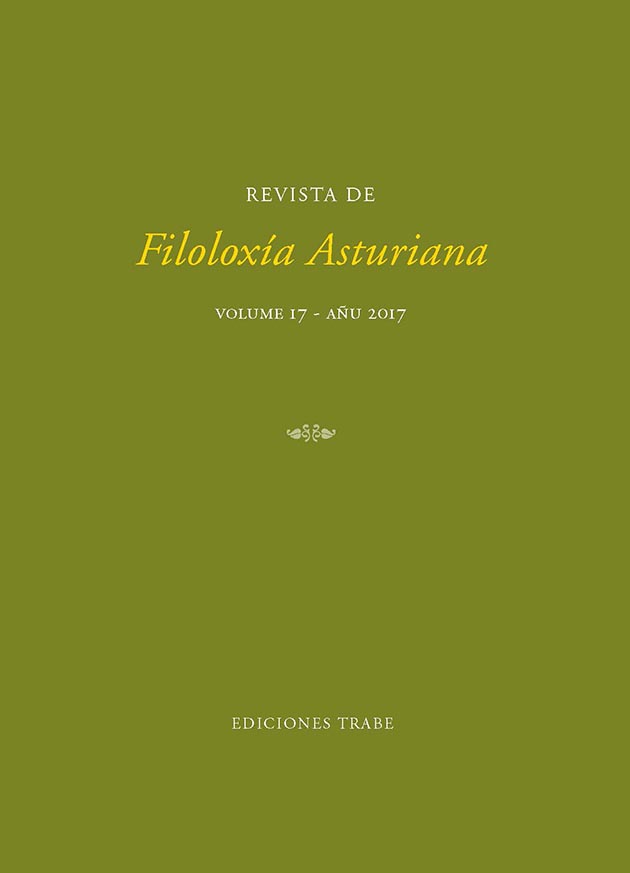Resumen
A partir de la reciente publicación de dos ediciones de poesía asturiana del siglo XVII, se examinan y sistematizan algunas informaciones sobre los poetas que participaron en los certámenes poéticos de 1639, 1665 y 1666. Los treinta años que separan uno y otros certámenes, y el ámbito jesuita donde se desarrolla el primero, hizo que muy pocos de los poetas que intervinieron en el de 1639 participasen en los que tuvieron lugar en la segunda mitad de siglo, hasta hace poco los únicos conocidos. Se pone en relación este tipo de poesía celebrativa que se compone en asturiano con lo que se produce en otros lugares de España. En el ámbito universitario salmantino se acogen textos en sayagués y también se emplea el sayagués (junto con el asturiano) en el certamen ovetense de 1639, en lo que pudo tener que ver la procedencia salmantina de su compilador, el P. Andrés Mendo. Sin embargo, mientras el sayagués pierde importancia en su uso literario a lo largo del XVII (ello se ve claramente en los villancicos), el empleo de otras lenguas irá en cambio en aumento a partir de este siglo. Ello es manifiesto en Galicia, en Navarra y en Asturias, cuyas lenguas vernáculas tendrán cabida en diversos certámenes durante este periodo. Se destaca el interés de otra nueva celebración poética de la que no había noticia hasta ahora: la que tiene lugar con la llegada a Asturias del obispo Ambrosio Ignacio de Spínola. En este contexto surge el nombre de un poeta completamente ignorado: Juan García de Prada, que muestra seguir de cerca el magisterio de Marirreguera en el uso de la octava real y de otros recursos literarios. Se dedica una especial atención al surgimiento de los primeros testimonios literarios manuscritos en asturiano que deben ser datados en la segunda mitad del XVII. Asimismo, se examina el caso particular de alguna obra regueriana: el Romance a Santa Eulalia de Mérida y el entremés de El Alcalde. De este entremés se ofrece una versión inédita contenida en un manuscrito de la primera mitad del XVIII, primer testimonio manuscrito de una obra de Marirreguera. Este testimonio presenta algunos rasgos lingüísticos (el empleo del pronombre -ye en función de dativo) que también aparecen en los poemas de García de Prada de la segunda mitad del XVII.
Palabras clave: poesía asturiana del XVII; poesía celebrativa; Juan García de Prada; Andrés Mendo; Marirreguera; historia de la lengua asturiana; teatro de ‘entremés’.
From the recent publication of two editions of Asturian poetry of the 17th century, some information on the poets who participated in the poetic contests of 1639, 1665 and 1666 are examined and systematized. The thirty years that separate one and other contests, and the Jesuit area where the first one was developed, made that very few of the poets who intervened in the one of 1639 could do so in those that took place in the second half of the century, the only ones known till recent times. This type of celebratory poetry that is composed in Asturian relates with what is produced in other places of Spain. In the University of Salamanca, texts are given in Sayagués, and the Sayagués (together with the Asturian) is also used in the competition of Oviedo in 1639, with which the Salmantine origin of its compiler, Fr. Andrés Mendo, could have had somethings to do. However, while the Sayagués lost importance in its literary use throughout the seventeenth century (this is clearly seen in the villancicos), the use of other languages will gradually increase from this century on. This is evident in Galicia, Pamplona and Asturias whose vernacular languages will have room in various competitions during this period. The interest of another new poetic celebration of which unknown is highlights: the one that takes place with the arrival in Asturias of the bishop Ambrosio Ignacio de Spínola. In this context comes the name of a completely ignored poet: Juan García de Prada, who shows to follow closely the magisterium of Marirreguera in the use of the real octave and other literary resources. Particular attention is given to the emergence of the first literary manuscripts testimonies in Asturian that must be dated in the second half of the xvii. Also the particular case of some Marirreguera’s work is examined: the «Romance to Santa Eulalia of Mérida» and the «El Alcalde» entremés. From this entremés an unpublished version contained in a manuscript of the first half of the xviii, first manuscript testimony of a work of Marirreguera is offered. This testimony presents some linguistic features (the use of the pronoun -ye in function of dative) that also appear in the poems of García de Prada of the second half of the xvii.
Keywords: Asturian poetry of the 17th century; celebratory poetry; Juan García de Prada; Andrés Mendo; Marirreguera; history of the Asturian language; theatrical ‘entremés’.

